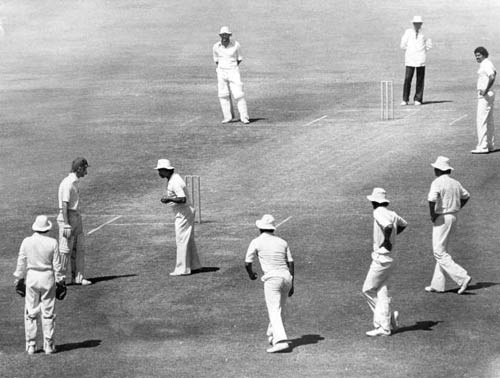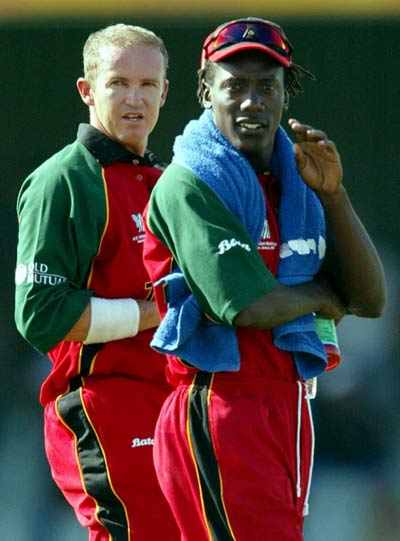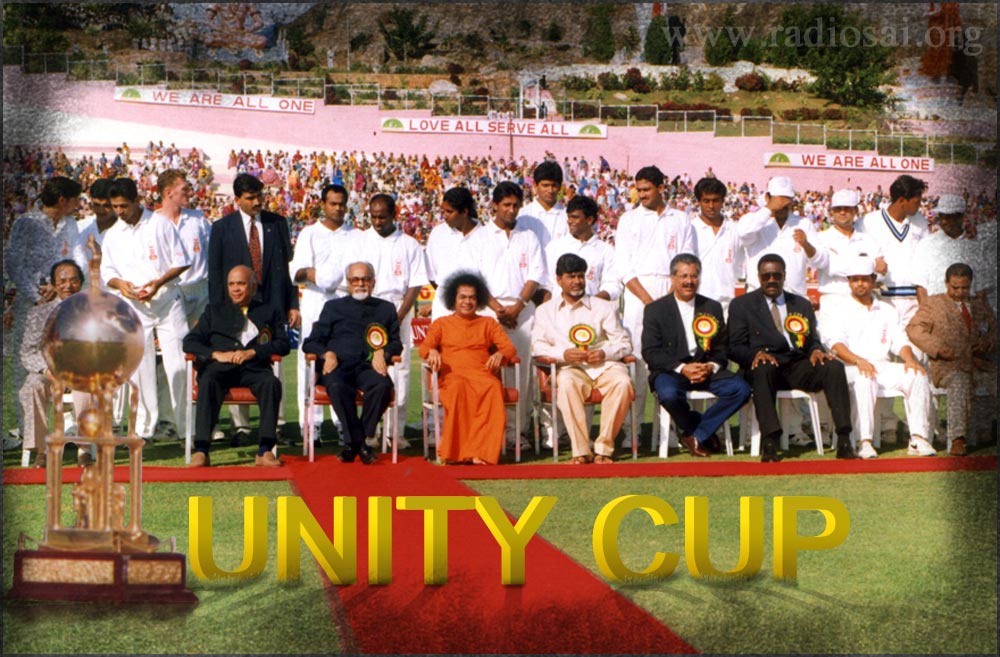|
|
| 'Like' us on Facebook | Follow us: |
Posted on: June 20, 2013
Refixing Cricket to Its True Character
- How to restore dignity in the 'gentleman's game'?
by Bishu Prusty (Radio Sai Team)
The events unfolding in Cricket India in the wake of the spot-fixing controversy and other related issues in the last few weeks has put every cricket-lover in this country in a fix.
Next time you sit down to watch a cricket match, another game begins in your mind – are these men on the field playing or acting? Are they really putting their heart and soul into the match in the true spirit of sportsmanship or is there something else working in the back of their minds manipulating their moves?
And then you begin to wonder, cricket was not like this when my father or uncle introduced me to this game and we talked endlessly about crease and stance, shots and catches.
So what has changed in this game in the recent times? Has it all got something to do with the way this game has transformed in the past few years?
 |
Remodelling Cricket
This supposedly gentleman's game underwent a 21st century makeover in the last couple of years, and thus emerged a format which is today more tuned towards being spiced-up entertainment than genuine sport (read IPL). In its present avatar, it’s a clever and savvy marketing idea to make the most of people's craze for this bat-and-ball tale and build the coffers of the national cricketing body. And as expected the devoted fans of this sport, which is no less than a religion in India, loved it.
Given the insatiable appetite for this national passion, every match was zealously followed and the stadiums overflowed with crowds. People emptied their pockets generously to buy these tickets, guised themselves into couch potatoes in front of television sets and surrendered themselves totally to the cricketing fanfare!
 |
|
| Cricket in the recent times has undergone many changes in its format, style and presentation and in the process its character has altered too |
Is there anything wrong with this? Maybe not. As the times change, everything acquires a new Avatar. Even God's descents in the modern era are not how it was 5000 years ago.
In the present fast-paced world, even die-hard connoisseurs of cricket would prefer a match which is a dazzling display of fours and sixes, catch-outs and run-outs, in a shorter time frame than waiting to see them during an entire day, or worse, over a period of five days.
So if the new format is doing its best to entertain people, and in the process a lot of people benefit – the players pocketing fat amounts, the cricketing bodies laughing their way to the bank and the audience relishing the fireworks on the field – why has every cricket-lover in the country today become somewhat sceptical?
Wrong Diagnosis = No cure + Adverse Side-effects
Isn't it because modern day cricket in some ways has distanced and at times divorced itself from its true spirit? Infact some fans have long suspected the undercurrents of this gentlemen’s game. “I stopped caring about cricket when I discovered like most Indians that the game is riddled with corruption,” says Kanti Bajpai, a columnist in a leading newspaper. “The shorter the version of the game, the more the corruption: The IPL saga illustrates that well enough.... what is delicious in the media circus of the past two weeks is that of course it is the media which has known from the beginning that cricket is thoroughly corrupt. How else did someone like me, 10 years ago, turn away from the game in disgust?”
While to paint the entire sport with the same brush of mistrust may be malapropos there is no denying the fact that the malaise that has gripped this prestigious and popular sport is too chronic and packed with lethal power to shake the very edifice of this historic game.
And so, similar to Bajpai a plethora of authors have lamented about the failings of the sport, and offered solutions ranging from abolishing the game for a couple of years to legalizing betting to even booing the President of the Indian cricket body during a public ceremony. Having only senior cricketers take over the game's central administration, bringing this high profile office under the Right to Information Act and divesting the IPL out of national cricket administration into separate revenue generating private activity are among the other ideas.
While each of them has its own merits, it isn’t really holistic in its approach. To me, they seem like treating one or two surface symptoms of a dreadful disease, without even looking at the malady in its entirety – forget about the right diagnosis of the root cause!
Reflecting on the current imbroglio, the Indian cricketing icon Sachin Tendulkar had said, “I join every cricketer, from the boys in the maidans... to those who represent the country, who trust the authorities to get to the root of the issue.”
The solution lies in getting to the root of the issue. To best understand where exactly this game went awry, let’s start with instances when everything was right.
When the Spirit of Cricket Ruled Over Everything Else
 |
|
| England's Bob Taylor is recalled by Indian skipper G. R. Viswanath in the Golden Jubilee Test at Bombay in 1980. |
Let’s go back 30 years. In 1980, Gundappa Vishwanath, the 'square cut specialist', was the captain of the Indian team. In a Mumbai test match against England, he was fielding at slips when Bob Taylor was at the crease. One of the balls had the batsman caught behind the wicket and the umpire upheld the appeal as well, but the Indian skipper had other ideas. He doubted the sound he heard – was it really the ball hitting the bat and not the bat brushing the pad?
So he just walked up to Bob and asked him if he had nicked it and the batsman replied in negative. Then without much ado, Vishwanath went to the umpire and had him reverse the decision. And during this entire episode there was never a second thought in the mind of this no-nonsense captain about what he did. "Obviously, as captain you play hard to win. But there are times when it's your inner call that tells you what is right," he said later. For him, the cause of cricket was much higher than somehow getting rid of a batsman.
Then there’s this story that the great cricketing legend Sunil Gavaskar had once narrated. In the days when he was a new entrant to international cricket, he had an opportunity to play against the best side in the world then - the West Indies. Rohan Kanhai, the West Indian batsman, who was much older and experienced than him, used to give him inputs to tackle pace bowling effectively.
And interestingly he offered his tips not only when the two were off the field but also when they were on the field as the match was in progress. Even though he was in the opposite team, he did not stop from honing the skills of a young cricketer in whom he saw tremendous potential as an opening batsman. For Rohan, working for the lasting glory of the sport selflessly was definitely more important than securing the wicket of a young lad.
 |
|
New Zealand's Daniel Vettori |
More recently, in November 2011 during a test match between New Zealand and Zimbabwe, Daniel Vettori, the Kiwi left-arm spinner accidentally collided with the non-striker Malcolm Waller during his follow-through. The clash hindered Waller from taking a single, and by that time the striker Regis Chakabva was too far down the track to get back. Though the wicketkeeper Reece Young took off the bails, Vettori immediately indicated that he had blocked Waller, who would otherwise have taken the run comfortably.
So he went up to the umpire and declared that he was taking back New Zealand's appeal. Regis Chakabva stayed on to continue his innings. When asked later about this incident, Vettori said, “It was just the right thing to do at the time...” For him, obviously the spirit of cricket was more important than the result of that one match.
In contrast, this is what a survey, commissioned by Marylebone Cricket Club (MCC) - guardian of the Laws and Spirit of Cricket - and the Cricket Foundation charity discovered and published two years ago in England: More than half of children (52%) aged eight to 16 say they see unfair play regularly in their games. Sledging, elbowing, tripping, hair-pulling, feigning injury and arguing with the umpire were among many examples of unfair play quoted by the youngsters. Though we do not have any such data concerning the young players in India or other countries, this does give us a drift of where the root of the problem lies.
There are several professional cricket academies in India and elsewhere and plenty of grooming and training happens outside these bodies too. While all these institutions – formal, informal and semi-formal – do their best to bolster and refine the technical skills of their lads, one wonders if as much emphasis is given to instill in them the character traits which will shape them as dignified messengers of this respectable game.
 |
|
| Andy Flower (left) and Henry Olonga |
If maintaining the sanctity of the sport without yielding to any temptations at any cost is stressed upon as much as playing the pull shot with the right footwork, if being steadfast with the discipline of this sport is emphasised and ingrained in them as strongly as always being alert and agile in the ground to save a run, we will have taken steps in the right direction to redeem the game. As we polish the raw talent of these youngsters we also need to power their sense of discrimination and discipline, so that the voice of conscience within them is never subdued or drowned in the frenzy of this competitive sport.
“The reward is to look in the mirror with a clean conscience” - Henry Olonga
An outstanding example of how listening to the 'voice of conscience' raised the character of the cricketers as well as of this sport happened during the 2003 World Cup.
During Zimbabwe's opening match at Harare Sports Club, Andy Flower and Henry Olonga sported black armbands to “mourn the death of democracy” in their country; it was against the Mugabe regime.
Both players realised that this would invite harsh consequences. "I suppose such was my conviction that this was the right thing to do that I felt it was necessary to stick to my principles no matter what. In that way at least I would know that I would have no regrets," said Olonga later on. And this did cost Olonga his professional career.
Four years after this, when a journalist asked him if he thought what he did then was worth it, Olonga said, “It was well worth it. It taught me the importance of standing up for one's beliefs, even in the face of incredible opposition.... For a brief moment, the glare of the world's media focused on a not so oft spoken nation that has a tremendous amount of suffering. I am aware we didn't change anything tangible, but maybe, somewhere in it all, we held a beacon of hope for some. For others, maybe we spoke words they had no voice to speak, and maybe for others yet we challenged their own world view in a way that they could reflect on their own lives and revel in the freedoms they enjoy... such is my conviction that we ought to do what is right when given the chance. In that way we can live life with few regrets. It will cost us something, but the reward is to look in the mirror with a clean conscience."
And Andy Flower, the England Coach in April 2012, during the summer break was running the London Marathon in aid of three charities.
Both of them in their own way have taken the glory and goodness of this sport beyond the game and leveraged it to even promote peace and wellbeing in society. While training his players, Andy often talks about making them better - not just better cricketers but better men too.
What Can Save the Charisma of Cricket?
Indeed sports should make men out of boys and not the opposite. But sadly today given the onslaught of commercialisation of the game and nexus between politics, business and markets, this sport hasn’t quite succeeded as it had previously. More often than not, the value systems of the players aren’t strong enough to withstand the pressures of the modern times. And this is really where the root of the problem is. It is therefore imperative that all organisations and bodies concerned with this game focus their maximum energies on ‘fixing’ this deficiency. In every training programme be it in India or abroad, let 'value education', 'character building', 'conscience listening' – call it what you will, receive as much spotlight as how to play a square cut or how to manage the media or how to handle your endorsements.
It might take a while before we see the results of this approach but this is the only lasting panacea to save the game from peril. The decline of the game may be temporarily stemmed by changing one official or punishing a player, but the disease will continue to relapse because we are content with treating only the symptoms.
While speaking to the students of His University on the Inaugural day of the Annual Sports and Cultural Meet on January 14, 1990, Bhagawan Baba said:
 |
“In the beginning, sports and athletics were intended mainly to promote health and experience joy. Today these objectives are being forgotten. Everything is being commercialised. Self-interest is getting predominant. Consequently, peace and happiness are being lost...
"In cricket and tennis matches today, lakhs of rupees are involved. When sports become a kind of business, there is no room for human values and peace becomes a casualty. It is essential, therefore, that the sense of spiritual oneness should prevail, transcending differences of nationality, language and religion. Only thus can real happiness and bliss be experienced.”
Commerce has always been a part of the game, but today sadly it has overpowered this sport and the way out of this is to raise the spirit of the game or rather live up to its true character.
Unity Duel in the Presence of Divinity
Perhaps to only demonstrate this Spirit of Cricket which should truly promote the sense of oneness, peace and joy, Baba permitted Sunil Gavaskar, Erapalli Prasanna & Co to organise an international cricket match between India XI and World XI way back in 1997 – the Sri Sathya Sai Unity Cup - in the town of Puttaparthi in the Sri Sathya Sai Hill View Stadium.
And what a glorious moment for this sport it was as the Divine graced the occasion! Perhaps few other sports can boast of such a privilege. With commerce completely out of the picture (not only no gate fee but also free lunch and breakfast to the crowd!), this game was pervaded with goodness, selflessness and unity (is there any other ground in the world where Buddha, Jesus, Zoroastra and Shiva stand atop as spectators!). And of course there was plenty of thrill too with India XI piling up 289 runs, thanks to Sachin's blitzkrieg! And finally the Master Blaster lifting the Sri Sathya Sai Unity Cup in the Divine Presence.
Maybe it is a good time to relive those glorious moments and brighten our day even as we wait for the dark clouds hovering on this game to soon clear away.
Click on the image for the Photo Gallery
 |
Graphics: Mohan Dora (Radio Sai Team)
What are your impressions about this article? Please share your feedback by writing to h2h@radiosai.org. Do not forget to mention your name and country.






